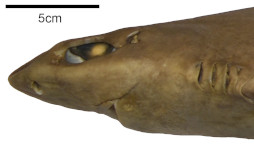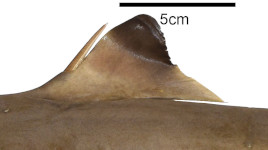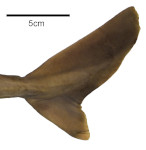Squalus clarkae
Pfleger, Grubbs, Cotton & Daly-Engel, 2018
Classification: Elasmobranchii Squaliformes Squalidae
Reference of the original description
Squalus clarkae sp. nov., a new dogfish shark from the Northwest Atlantic and Gulf of Mexico, with comments on the Squalus mitsukurii species complex. Zootaxa, 4444(2), 101–119
Squalus clarkae sp. nov., a new dogfish shark from the Northwest Atlantic and Gulf of Mexico, with comments on the Squalus mitsukurii species complex. Zootaxa, 4444(2), 101–119
Types
Squalus clarkae
Holotype: FMNH: UF239318; Paratype: FMNH: UF239320; FMNH: UF239319; FSUCML: FSUCML875; FSUCML: FSUCML1016; FSUCML: FSUCML1018;
Squalus clarkae
Holotype: FMNH: UF239318; Paratype: FMNH: UF239320; FMNH: UF239319; FSUCML: FSUCML875; FSUCML: FSUCML1016; FSUCML: FSUCML1018;
Description :
Citation: Squalus clarkae Pfleger, Grubbs, Cotton & Daly-Engel, 2018: In: Database of modern sharks, rays and chimaeras, www.shark-references.com, World Wide Web electronic publication, Version 01/2026
Please send your images of "Squalus clarkae" to info@shark-references.com

Squalus clarkae Pfleger, Grubbs, Cotton & Daly-Engel, 2018; FMNH UF239318, holotype, female, adult, 712.5 mm TL, Gulf of Mexico © R. Dean Grubbs

Squalus clarkae Pfleger, Grubbs, Cotton & Daly-Engel, 2018; FMNH UF239318, holotype, female, adult, 712.5 mm TL, Gulf of Mexico © R. Dean Grubbs
Common names
 Genie’s Dogfish,
Genie’s Dogfish,  Gulf Dogfish
Gulf Dogfish
 Genie’s Dogfish,
Genie’s Dogfish,  Gulf Dogfish
Gulf Dogfish
Short Description
Original diagnosis after PFLEGER, GRUBBS, COTTON & DALY-ENGEL, 2018 [26389]: Squalus clarkae sp. nov. is a relatively large dogfish shark with a fusiform body, short head, and an interdorsal space ranging from 24.6% to 25.8% of TL. Head length is 21.2– 21.9% TL, and head width measures 1.08–1.2 times width at the mouth and 1.73–1.8 times width at the nostrils. Head height is about half the length of the head. Pre-vent length is 50.1–51.1% of the TL. S. clarkae sp. nov. is relatively short snouted, with a prenarial length 0.64–0.69 times mouth width and 1.32–1.59 times eye length. Interorbital space is equal to that of the mouth width, and prenarial length is 0.52–0.55 times preoral length. Eye length is 1.60–1.88 times eye height. Spiracle length is 1.0–1.2% of the TL of the animal. Fifth gill slit height is slightly larger than (1.2–1.4 times) first gill slit height. Mouth width is 0.78–0.82 times the pre-oral length. Innernostril labial furrow space is 1.54–1.89 times labial furrow length, and preoral length is 1.9–2.1 times the internarial space. Pre-first dorsal fin length 30.5–31.4% of the TL of the animal. First dorsal fin length measures 1.92–2.10 times first dorsal fin height. First dorsal fin length is approximately equal to that of the second dorsal fin (0.98–1.08 times); however, the height of the first dorsal fin is 1.50–1.68 times the height of the second dorsal fin. Pre-second dorsal fin length is 60.8–63.0% of the TL of the animal. Second dorsal fin length 2.97–3.28 times the second dorsal fin height. Second dorsal spine length is 1.05–1.17 times the length of the first dorsal spine, and second dorsal spine base width is 0.78–1.02 times the first dorsal spine base width. The pectoral fin inner margin was 7.0–8.4% of the TL, and pectoral anterior margin was 2.49–2.81 times the pectoral fin base length. Pelviccaudal space is 1.05–1.12 times the pectoral-pelvic space, and 1.24–1.28 times the prepectoral length of the organism.
Original diagnosis after PFLEGER, GRUBBS, COTTON & DALY-ENGEL, 2018 [26389]: Squalus clarkae sp. nov. is a relatively large dogfish shark with a fusiform body, short head, and an interdorsal space ranging from 24.6% to 25.8% of TL. Head length is 21.2– 21.9% TL, and head width measures 1.08–1.2 times width at the mouth and 1.73–1.8 times width at the nostrils. Head height is about half the length of the head. Pre-vent length is 50.1–51.1% of the TL. S. clarkae sp. nov. is relatively short snouted, with a prenarial length 0.64–0.69 times mouth width and 1.32–1.59 times eye length. Interorbital space is equal to that of the mouth width, and prenarial length is 0.52–0.55 times preoral length. Eye length is 1.60–1.88 times eye height. Spiracle length is 1.0–1.2% of the TL of the animal. Fifth gill slit height is slightly larger than (1.2–1.4 times) first gill slit height. Mouth width is 0.78–0.82 times the pre-oral length. Innernostril labial furrow space is 1.54–1.89 times labial furrow length, and preoral length is 1.9–2.1 times the internarial space. Pre-first dorsal fin length 30.5–31.4% of the TL of the animal. First dorsal fin length measures 1.92–2.10 times first dorsal fin height. First dorsal fin length is approximately equal to that of the second dorsal fin (0.98–1.08 times); however, the height of the first dorsal fin is 1.50–1.68 times the height of the second dorsal fin. Pre-second dorsal fin length is 60.8–63.0% of the TL of the animal. Second dorsal fin length 2.97–3.28 times the second dorsal fin height. Second dorsal spine length is 1.05–1.17 times the length of the first dorsal spine, and second dorsal spine base width is 0.78–1.02 times the first dorsal spine base width. The pectoral fin inner margin was 7.0–8.4% of the TL, and pectoral anterior margin was 2.49–2.81 times the pectoral fin base length. Pelviccaudal space is 1.05–1.12 times the pectoral-pelvic space, and 1.24–1.28 times the prepectoral length of the organism.
Distribution
Gulf of Mexico, West Florida Slope off of Tampa, Florida to the west side of the head of DeSoto Canyon off Louisiana [26389] Source: www.gbif.org
Gulf of Mexico, West Florida Slope off of Tampa, Florida to the west side of the head of DeSoto Canyon off Louisiana [26389] Source: www.gbif.org
Dentition
The teeth are similar in appearance in the upper and lower jaw, each with a strongly oblique, laterally–directed cusp without serrations or cusplets. Each tooth has a broad base and a deep lateral notch below the cusp. Total number of teeth range 27–29 in the upper jaw and 23–24 in the lower jaw, with no observed differences in dental formula or tooth morphology between sexes. [26389]
The teeth are similar in appearance in the upper and lower jaw, each with a strongly oblique, laterally–directed cusp without serrations or cusplets. Each tooth has a broad base and a deep lateral notch below the cusp. Total number of teeth range 27–29 in the upper jaw and 23–24 in the lower jaw, with no observed differences in dental formula or tooth morphology between sexes. [26389]
Remarks
shark-references Species-ID=15073;
shark-references Species-ID=15073;




















